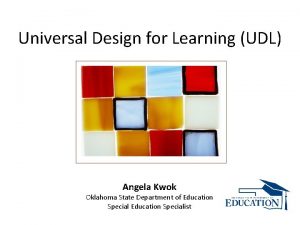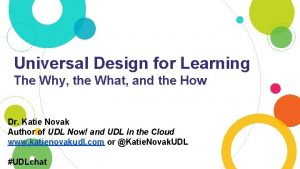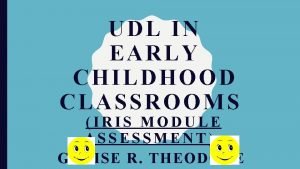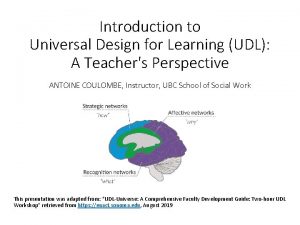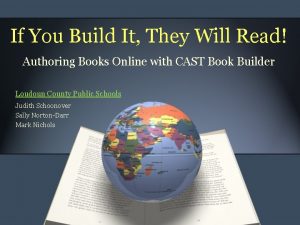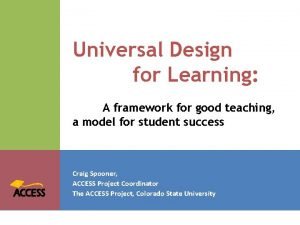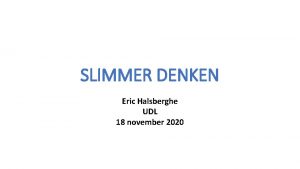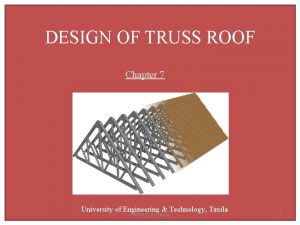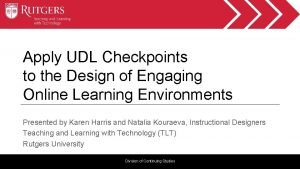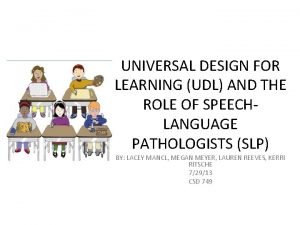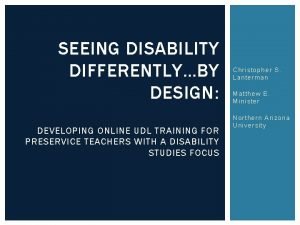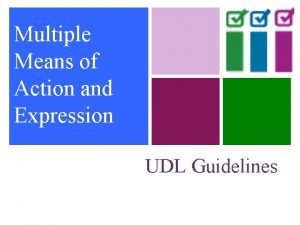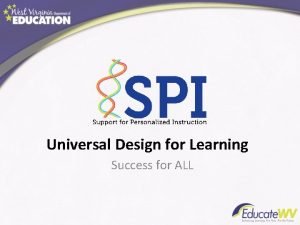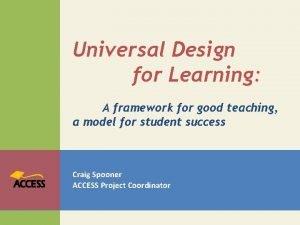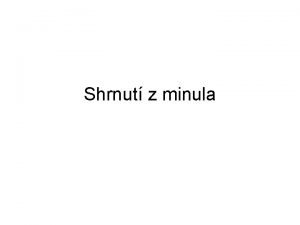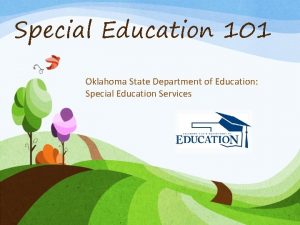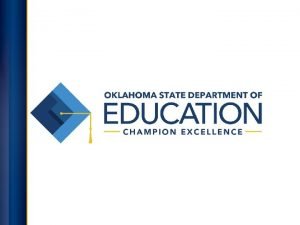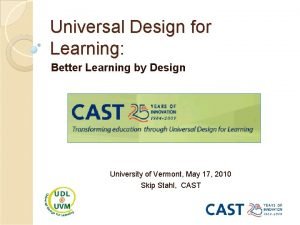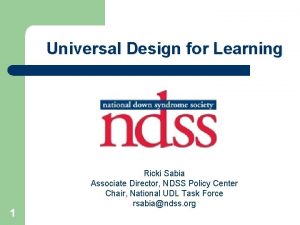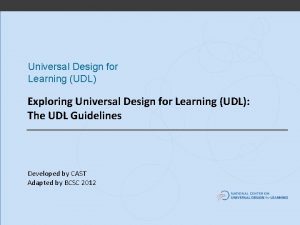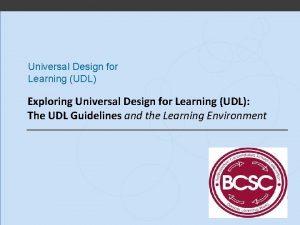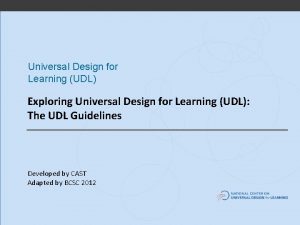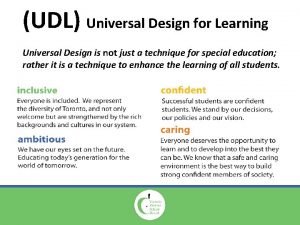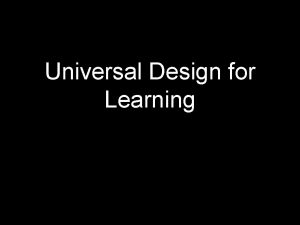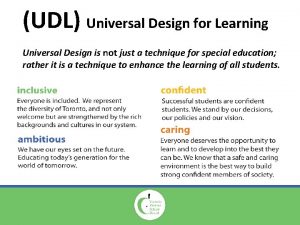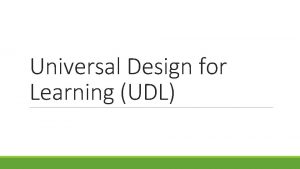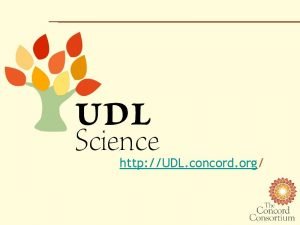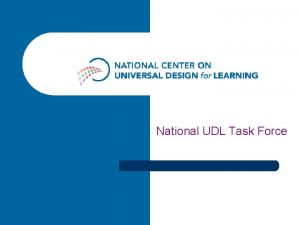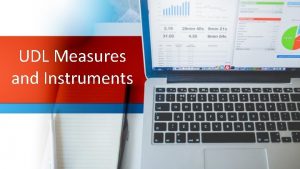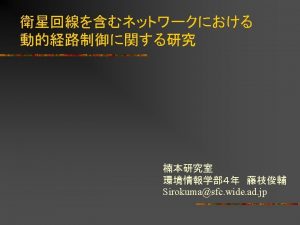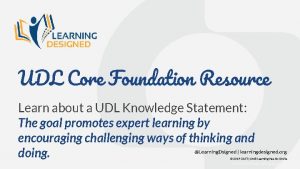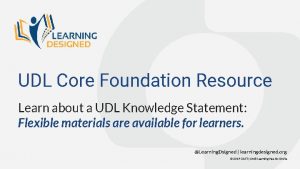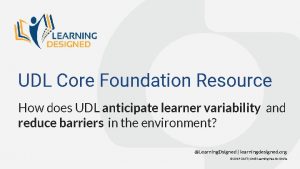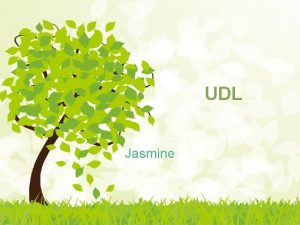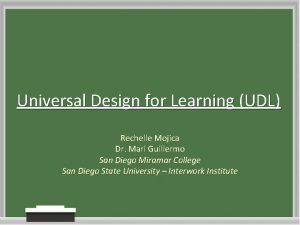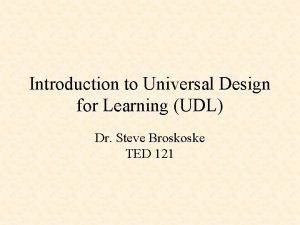Universal Design for Learning UDL Exploring Universal Design






















- Slides: 22

Universal Design for Learning (UDL) Exploring Universal Design for Learning (UDL): The UDL Guidelines Developed by CAST Adapted by BCSC 2012 Ralabate, October 2011

Essential Questions § What is Universal Design for Learning (UDL)? § How are the UDL Guidelines structured? § How can I use the UDL Guidelines for effective planning? Ralabate, October 2011 CAST, March 2012

tip: This exercise 1 st Question: “What is UDL? ” UDL activates background knowledge and recruits interest. What do I know? How did I learn it? Ralabate, October 2011 CAST, March 2012

3 Networks = 3 UDL Principles Ralabate, October 2011 UDL tip: This graphic offers information in text, visuals, & color.

Universal Design for Learning (UDL) UDL Principles § Multiple Means of Engagement (Affective) § Multiple Means of Representation (Recognition) § Multiple Means of Action and Expression (Strategic) What UDL is http: //www. udlcenter. org/aboutudl/whatisudl The UDL Guidelines http: //www. udlcenter. org/sites/udlcenter. org/files/updateguide lines 2_0. pdf Ralabate, October 2011 CAST, March 2012

UDL tip: This video offers information in another medium. http: //www. youtube. com/watch? v=b. Dv. Kn. Y 0 g 6 e 4 Ralabate, October 2011 CAST, March 2012

2 nd Question: “How are the guidelines structured? ” UDL tip: Asking key questions, prepares & scaffolds learning. What do you know and understand about the three principles? What do you know and understand about the nine guidelines? Ralabate, October 2011 CAST, March 2012

http: //www. udlcenter. org/sites/udlcenter. org/files/updateguidelines 2_0. pdf Ralabate, October 2011

Universal Design for Learning REPRESENTATION Input The “What? ” of learning Options to see, hear and perceive information: _____________________________________ ___________________ Options to decode language, math, symbols: _____________________________________ ___________________ Options to make sense and understand knowledge: _____________________________________ ___________________ ACTION/EXPRESSION Output The “How? ” of learning ENGAGEMENT Connection The “Why? ” of learning Options to do, move and interact: __________________________________ _________________ Options to differentiate expression of knowledge: __________________________________ _________________ Options to plan, strategize and initiate action: __________________________________ _________________ Options to care, value and find relevance: ___________________________________ ___________________________________ Options to vary challenge and/or support: Scaffolding: support for understanding & varies challenge and/or support. ___________________________________ __________________ Options to set goals and self regulate: ___________________________________ __________________ Bartholomew Consolidated School Corporation 2012

Universal Design for Learning: Examples ACTION/EXPRESSION Output The “How? ” of learning REPRESENTATION Input The “What? ” of learning Options to see, hear and perceive information: Options to do, move and interact: ENGAGEMENT Connection The “Why? ” of learning Options to care, value and find relevance: EXAMPLES: Game, Acting/Role playing, Demonstrate, Lab, Speech, Typing, Recording EXAMPLES: Video, Lecture, Demonstration, Diagram, Story, Textbook, Website EXAMPLES: Discussion, Guest speaker, Journaling, Video, Experiment Options to decode language, math, symbols: EXAMPLES: Text to speech, Manipulatives, Pictures Options to differentiate expression of knowledge: EXAMPLES: Journaling, Oral expression, Timeline, Worksheet, Exam Options to vary challenge and/or support: EXAMPLES: Learning Center, Small Group Activity, Discrepant Event, Worksheet, Internet Options to make sense and understand knowledge: Options to plan, strategize and initiate action: EXAMPLES: Graphic Organizer, Clues, Prompts, Aided Questions, Models EXAMPLES: Project, Portfolio, Create a video Options to set goals and self regulate: EXAMPLES: Interest Inventory, Reflection, Survey, Goal Setting Activity Examples and modeling provide scaffolding. Bartholomew Consolidated School Corporation 2012


What is Curriculum? Curriculum includes: § Goals § Assessment § Methods § Materials/Media Ralabate, October 2011 CAST, March 2012

A word about Goals aligned with UDL – Are flexible – Allow multiple ways for learners to achieve them – Do NOT embed the means for achieving the goal unnecessarily UDL tip: Highlighting certain words aids comprehension.

3 rd Question: How can I use the UDL Guidelines for effective planning? UDL tip: Asking key questions, prepares & scaffolds learning. How do we align the UDL Guidelines with curriculum planning? What questions would you ask of yourself while planning? Ralabate, October 2011 CAST, March 2012

Engagement Goals § § What is the goal of this TASK? Is the means embedded? • Assessment §How do I know they’re getting it? § § § § § • Methods/Materials §What instructional strategies, techniques? §Which tools, media & supplies? § § § Do goals allow for self-advocacy/choice making/socially appropriate responses? Can collaboration enhance motivation/generalization? Am I allowing for exploration? Are the demands appropriate for level(s) of socioemotional development? What incentives will enhance performance? Are learners able to self-monitor progress? Reflect on performance? Correct errors? Are the learners offered choice/options? Do the demands and resources match or optimize challenge? Does evaluation cause anxiety? Is the activity meaningful? Functional? Relevant? Are materials safe? How do social dynamics affect the techniques or tools/media? Do materials distract from efforts? Do methods/materials need to be personalized?

Representation Goals § § What is the goal of this TASK? Is the means embedded? Assessment §How do I know they’re getting it? § § Is repetition needed? How much scaffolding? Fading? Prompting? Are both content & its representations meaningful? Am I offering both linguistic and non-linguistic representation? Is there flexibility? § § Are there external factors affecting performance? Am I working within their Zone of Proximal Development (ZPD)? Am I providing too much/too little support? Am I providing a practice period? Are representations meaningful? Is there flexibility? § § § Methods/Materials §What instructional strategies, techniques? §Which tools, media & supplies? § § § § Am I defining vocabulary? Clarifying syntax/structure? Am I offering multiple exemplars? Models? NONexamples? Are there language/cultural barriers? Am I making use of technology? Multi-media? Are the critical features/big ideas highlighted? Am I activating background knowledge? Are there transfer & generalization options?

UDL tip: Reflection questions foster collaborative learning. What questions would you ask to address action and expression? Ralabate, October 2011 CAST, March 2012

Action & Expression Goals § § What is the goal of this TASK? Is the means embedded? Assessment §How do I know they’re getting it? Methods/Materials §What instructional strategies, techniques? §Which tools, media & supplies?

Action & Expression Goals § § What is the goal of this TASK? Is the means embedded? Assessment §How do I know they’re getting it? Methods/Materials §What instructional strategies, techniques? §Which tools, media & supplies? § § Are alternative means allowed? (e. g. , draw, point, describe) What alternative or AT tools are in IEP? Do goals focus on communication with peers? Adults? Are multiple expression outlets allowed? Are graduated levels of support addressed? Is the learner involved in goal setting? § § § What supports are needed for responses? Is strategic development obvious in the assessment? Am I providing enough time for practice/formulation? Are multiple expression tools/options allowed? Are there supports for learner decision making? How do learners monitor their progress? § Do the methods/strategies support the learner in planning/developing strategic decision making? What AT, multi-media or other tools are necessary? Are materials age-appropriate/appealing? Do learners manage their own materials/resources? § §

Summary § UDL is based on what we’ve learned in neuroscience and the learning sciences about HOW we learn. § There are 3 brain networks associated with learning: Affective, Recognition, Strategic and 3 UDL Principles offering multiple means of: Engagement, Representation and Action & Expression. § There are 3 Guidelines for each UDL Principle = 9 UDL Guidelines moving from access to comprehension and deep engagement. § We can plan a UDL Curriculum (Goals, Assessment, Methods, Materials/Media) by asking questions based on the UDL Guidelines. Ralabate, October 2011 CAST, March 2012

Next Steps: § YOU: – Focus on one lesson or unit. – Be self reflective of a previous lesson or unit. – Use the tools and resources. – Design the lesson. – Have FUN!!!! § YOUR SUPPORT: – Evaluate your needs and barriers. – Provide additional support, scaffolding and professional development

Resources § http: //cast. org/ § http: //bookbuilder. cast. org/ § http: //udlexchange. cast. org/home § http: //www. udlcenter. org/ § BCSC UDL Website § laswellr@bcsc. k 12. in. us
 Difference between udl and differentiation
Difference between udl and differentiation Mtss and udl
Mtss and udl Iris udl
Iris udl Strain energy
Strain energy Ron mace
Ron mace Udl book builder
Udl book builder Udl nontraditional students
Udl nontraditional students Udl voorbeelden
Udl voorbeelden Truss self weight
Truss self weight Heighten salience of goals and objectives
Heighten salience of goals and objectives Udl
Udl Udl
Udl Multiple means of action and expression
Multiple means of action and expression Iris udl assessment answers
Iris udl assessment answers Udl percentage
Udl percentage Fce udl
Fce udl 504 plan oklahoma
504 plan oklahoma Universal design for learning
Universal design for learning Universal design for learning
Universal design for learning Universal design for learning
Universal design for learning Cuadro comparativo e-learning b-learning m-learning
Cuadro comparativo e-learning b-learning m-learning Fspos vägledning för kontinuitetshantering
Fspos vägledning för kontinuitetshantering Typiska novell drag
Typiska novell drag
